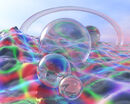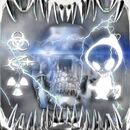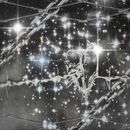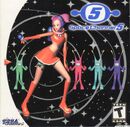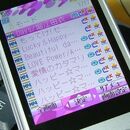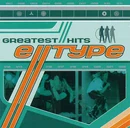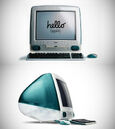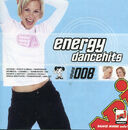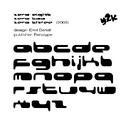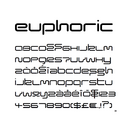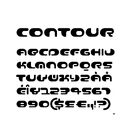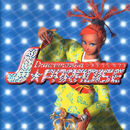Y2K (also known as Kaybug) is an aesthetic that was prevalent in popular culture from roughly 1995 to 2003. Named after the Y2K Bug, it is characterized by a distinct aesthetic period, encapsulating fashion, hardware design, music, and furnishings shining with tech optimism — sometimes literally. According to the Y2K Aesthetic Institute, some of its aspects include tight leather pants, silver eyeshadow, shiny clothing, Oakleys, gradients, and Blobitecture. Most Y2K aesthetics rely on the use of technology and slick futuristic looks, signaling the optimism of a new era as the 20th century/2nd millennium progressed into the 21st century/3rd millennium. One of the earliest definers of the Y2K aesthetic is the Designers' Republic, a Sheffield-based graphic design studio best known for their work on the Wipeout video game franchise and various album artwork. The Y2K era ended in 2003 and was succeeded by the Frutiger Aero and McBling era.
Y2K aesthetics could've possibly been inspired by other previous futuristic aesthetics such as Retro-Futurism. Some elements of Y2K (especially from the earlier portion of the era) would also cross over into the Vaporwave aesthetic, since it shares Vaporwave's angst towards late-stage capitalism, and its nostalgic desire to retreat into a retrofuturist world promised before Western society entered its current troubled times. However, the Y2K aesthetic has not yet been explored by the Vaporwave scene as much as earlier, more ubiquitous periods (like the '80s–early '90s Neon/Synthwave aesthetic).[1]
History
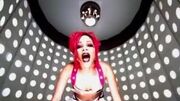
Early 2000s Commercials
A compilation of Y2K-themed commercials.
First major signs of the Y2K aesthetic appeared around 1995 to 1997, with the release of Windows 95, the movie Hackers, the PS1 game Wipeout, and music videos by artists such as Michael and Janet Jackson ("Scream"), Puff Daddy ("Mo Money Mo Problems"), Will Smith ("Gettin' Jiggy wit It", "Men in Black"), and the Spice Girls ("Say You'll Be There") being done in this style. The Y2K era then took off in full force from 1998 to 2000, with things such as Pokemania, Limp Bizkit, NSYNC, TRL, The Matrix, and Britney Spears hitting their peak popularity. Y2K replaced the Core '90s era which had been known for its darker, more serious tone, with aesthetics such as Grunge. Y2K peaked around late 1999/early 2000, coinciding with the turn of the millennium and apex of the dot-com bubble.[2]
The Y2K era gradually declined from 2000 to 2003 as the contentious 2000 U.S. presidential election, the dot-com bubble bursting, 9/11, the anthrax scares, and the Iraq War dampened optimism for the new millennium. It finally ended in 2003, after which it gave way to the McBling and Frutiger Aero aesthetics. Although not as popular these days, Y2K culture can still be seen in various circles of the Internet and niche entertainment but is starting to see a bit of a resurgence in its imagery in pop culture as late '90s/early 2000s nostalgia has started coming back in fashion, such as in "1999" by Charli XCX, "2002" by Anne Marie, and "Motivation" by Normani.
Y2K during the era
Graphics and art
Y2K aesthetics both use 2D and 3D art. 2D art usually features thick lines, bold minimalism, and heavy use of iconography. 3D art is more "blobby" looking, has more gradients, and generally looks very shiny. Common colors used in Y2K art are, but not limited to, chrome, icy blue, ocean, bright oranges, glossy white, and black (for lineworks).
One of the most well-known faces of Y2K art is the Designers Republic, known for their works on the video game series Wipeout as well as various album artwork, especially for artists on the electronica label Warp Records. Founded by Ian Anderson and Nick Phillips in 1986, they were best known for making art that subverts brash consumerism and the uniformity of corporate culture (similar to what Vaporwave has done since then). Like vaporwave, much of their work also drew inspiration from Japanese anime (which was beginning to rise in popularity around the same time).
Music

Ivy Hollivana – Breaking Point (2019)
Since Y2K was about embracing the future, the tone of music also reflected this. Electronic music was the go-to genre to capture this era as a musician.
The most well-known music associated with Y2K is big beat, a subgenre of electronic music that used "heavy breakbeats and synthesizer-generated loops and patterns". Bands such as the Prodigy, Fatboy Slim, the Crystal Method, Junkie XL and Propellerheads performed this music during the '90s. However, the genre has since become less prevalent in the mainstream, with modern examples being few and far in between.
Other genres used during the Y2K era were jungle, drum n' bass and trance. Much like big beat (and what ultimately inspired big beat to begin with), these genres have a heavy emphasize on techno-style music, with fast beats and use of synthesizers. To this day, these genres are still used in EDM scenes all over.
Bubblegum eurodance was also common during the Y2K era. Aqua, the band responsible for the 1997 hit "Barbie Girl", is often attributed as being the most popular example of this genre, with an honorable mention going to Eiffel 65, known for their 1998 single "Blue (Da Ba Dee)".
The Y2K aesthetic can also be seen in the music video to the Red Hot Chili Peppers' "Californication". The video takes the form of a fictional open-world video game that depicts each of the band members on an adventure in a California setting.
R&B and hip-hop also transitioned from the Golden Age/Gangsta Rap & G-Funk Era into the Bling/Shiny Suit/Jiggy Era. Many hip-hop artists used Y2K aesthetics in music videos, such as TLC in their "No Scrubs" video, though on the Y2K Aesthetics Institute, there is a lyrics video for an artist named "Ivy Hollivana", who seems to invoke a lot of the Y2K imagery in her music videos, so she could potentially be to Y2K Music as Daniel Lopatin or James Ferraro were for Vaporwave.
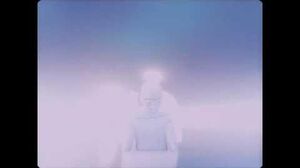
Ivy Hollivana – Dear Deathwaters (2019)
Perhaps the future of the Y2K Sound?
Spotify playlists
- Y2K Pop Spotify playlist by Alec Dawson
- Y2K Spotify playlist by m.quintos1
- y2k Spotify playlist by achooro
- Y2K (Early 00's) Spotify playlist by Indie Monster
- Y2K ANGEL Spotify playlist by josephina666
Movies
- Hackers (1995)
- Scream (1996)
- I Know What You Did Last Summer (1997)
- Titanic (1997)
- 10 Things I Hate About You (1998)
- Jawbreaker (1999)
- The Matrix (1999)
- American Pie (1999)
- Pokemon: The First Movie (1999)
- Fight Club (1999)
- Bring It On (2000)
- Donnie Darko (2001)
- Agent Cody Banks (2001)
- Legally Blonde (2001)
- Jay and Silent Bob Strike Back (2001)
- Zoolander (2001)
- Freddy Got Fingered (2001)
- Shrek (2001)
- Harry Potter and the Sorcerer's Stone (2001)
- Spider-Man (2002)
- Jackass: The Movie (2002)
- Ice Age (2002)
- Scooby-Doo (2002)
- Lilo & Stitch (2002)
- Kangaroo Jack (2003)
- The Matrix Reloaded (2003)
- The Matrix Revolutions (2003)
- Daredevil (2003)
- Finding Nemo (2003)
- Looney Tunes: Back in Action (2003)
- Garfield (2004)
- Yu-Gi-Oh! The Movie: Pyramid of Light (2004)
- The SpongeBob SquarePants Movie (2004)
- Catwoman (2004)
Video Games
When people think of Y2K gaming, most could tell you about the sixth generation of consoles (Dreamcast, PlayStation 2, Xbox, GameCube, GameBoy Advance) and their respective lines of games. The fifth generation of gaming (PlayStation, Nintendo 64, Sega Saturn, GameBoy Color) also contained early elements of Y2K, bridging the Core '90s into the Y2K Era.
During the late '90s and early 2000s, Sega had attempted to make one last console before they went out of business. The Dreamcast, released in 1999, had shown Sega's ability to make creative and innovative games. The most Y2K-esque game was 1999s Space Channel 5, a rhythm game intended for a "casual female audience" that was applauded for its retro art style and soundtrack, encapsulating a lot of what people admired about Y2K aesthetics.
Another Dreamcast game that could be considered Y2K-inspired is 2000's Jet Set Radio, which, while not having the slick designs of Space Channel 5, captured other aspects such as Japanese punk fashion and early 2000s hip-hop. Jet Set Radio would also use iconography-inspired graphics for its UI. Jet Set Radio Future, its 2002 sequel, would end up integrating even more Y2K aesthetics into its art and gameplay.
Yet more Sega games that embodied this aesthetic are Sonic Adventure (1999), Sonic Adventure 2(2001), and Sonic Heroes (2003), particularly SA1 with its janky-yet-charming visuals and atmospheric Y2K music.
On the Sony end of the spectrum, no game series does a better job of embodying the Y2K aesthetic than the Wipeout series, with art done by the aforementioned Designers Republic, even with recent iterations like Wipeout HD (2008) and Wipeout 2048 (2012).
Ace Combat 3: Electrosphere also used a Y2K futurism aesthetic in its user interface, fictional aircraft designs, and soundtrack.
Other companies attempted to use Y2K aesthetics as a promotion for consoles, controllers, and games.
Fashion
Y2K is a very new concept, but with certain brands that were popular at the time still existing, one could easily predict these brands could potentially play a huge role in Y2K. Basically, you'd either look like a late '90s/early 2000s raver or a member of a boy band from the time.
Y2K vendors
Also, it should be noted a lot of Holosexual aesthetics and style can turn up in Y2K fashion as well (due to its usage in futuristic fashion at the time).
Toys and Technology
Being that this was the era that the cell phone was first starting to become popular among your average consumer, you can find a lot of nods to the original models of cell phones (such as the original Nokia phones or the clamshell/flip phones) within the Y2K subculture. Also popular around this time was the Blobject, a type of design product (often a household object) distinguished by smooth flowing curves, bright colors, and an absence of sharp edges. The word is generally held to be a portmanteau, a contraction of "blob" and "object."
Blobitecture
Blobitecture, also known as 'blobism’, is a term given to a post-modern architectural style characterized by curved and rounded building shapes, or 'blob architecture'. Blobitecture buildings appear to have an organic form that is soft and free-flowing, yet comes together to produce a complex whole. Blobitecture buildings started popping up around the late 90's/early 2000s to reflect a lot of the trends at the time, giving the buildings something of a "futuristic" look at the time (by the standards of what constituted futuristic at that time period).
Y2K in Modern Culture
Some have taken an interest in the aesthetic in recent times. The Y2K Aesthetic Institute (run by Froyo Tam and Evan Collins) archive parts of the aesthetic, such as graphic designs, flyers, game console designs, video game concept art, fashion, etc. They chronicle both art from the era the aesthetic was popular, as well as modern depictions of the aesthetic. Tam has also made Ferrite Core DX and other open-source typefaces inspired by Y2K typography.
Another example of modern-Y2K aesthetics being used is the indie puzzle game known as CROSSNIQ+, which utilizes the more bold, thick-line aesthetics seen in Y2K cartoon styles. Also run by Krieger and The Y2K Institute is u::r::here, a free virtual gallery dedicated to showing off Y2K art and aesthetics.
So far there is only one community forum that is based on Y2K aesthetics and that is Agora Road's Macintosh Cafe. Which coins itself as a "nostalgic Y2K community".
The aesthetic seems to be breaking into pop culture, such as the Charli XCX and Troye Sivan song 1999.
DV-i is a music artist seeking to revive the feel of Y2K techno.




